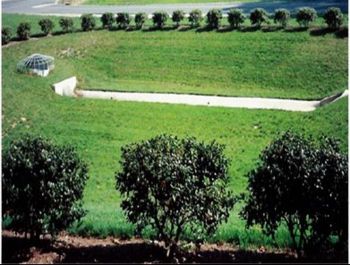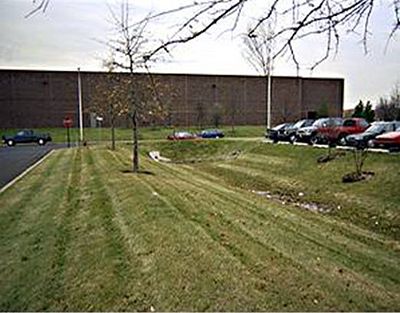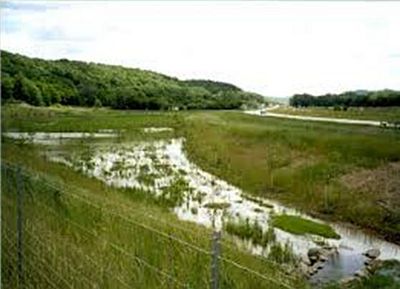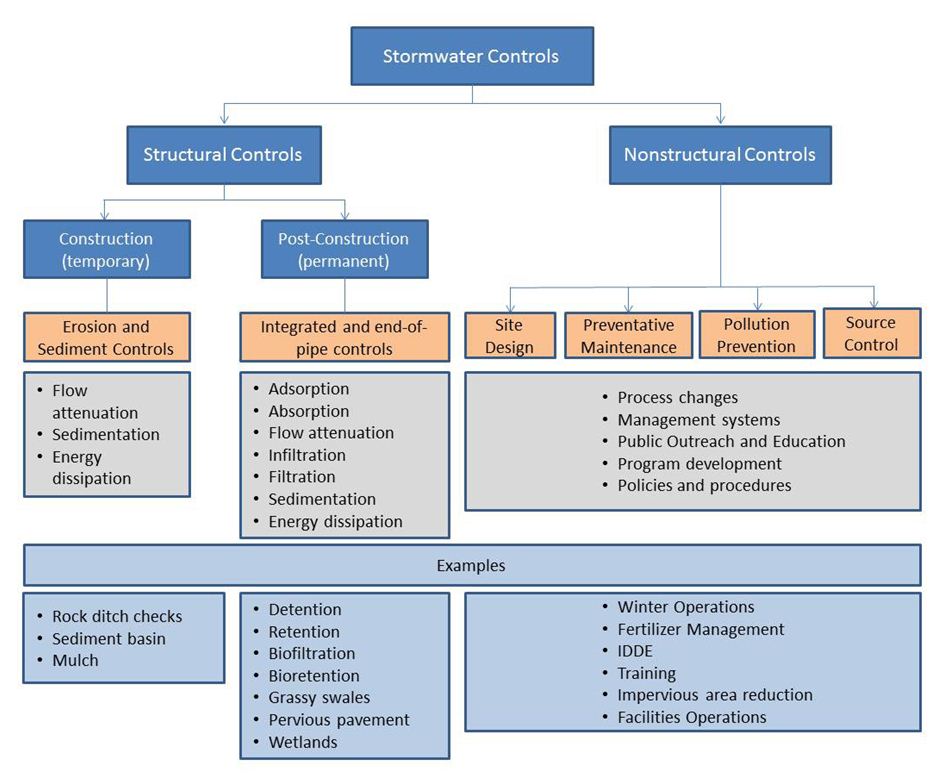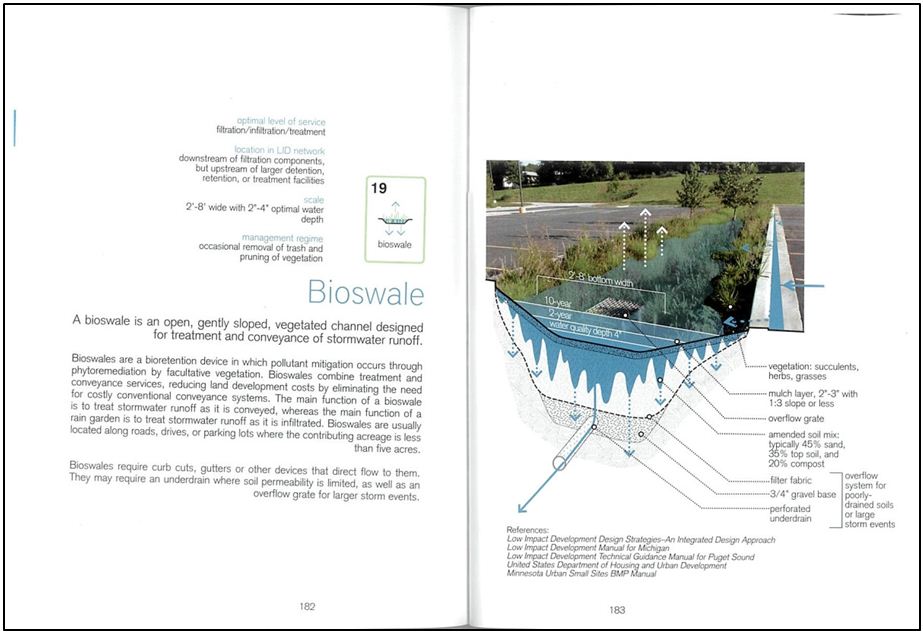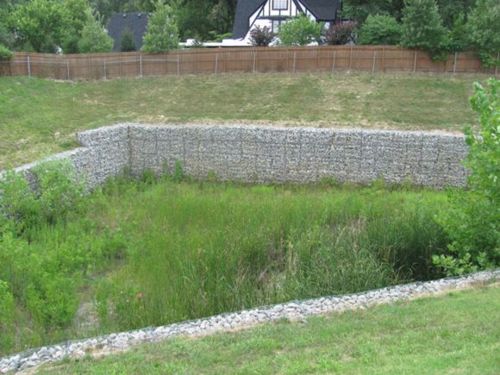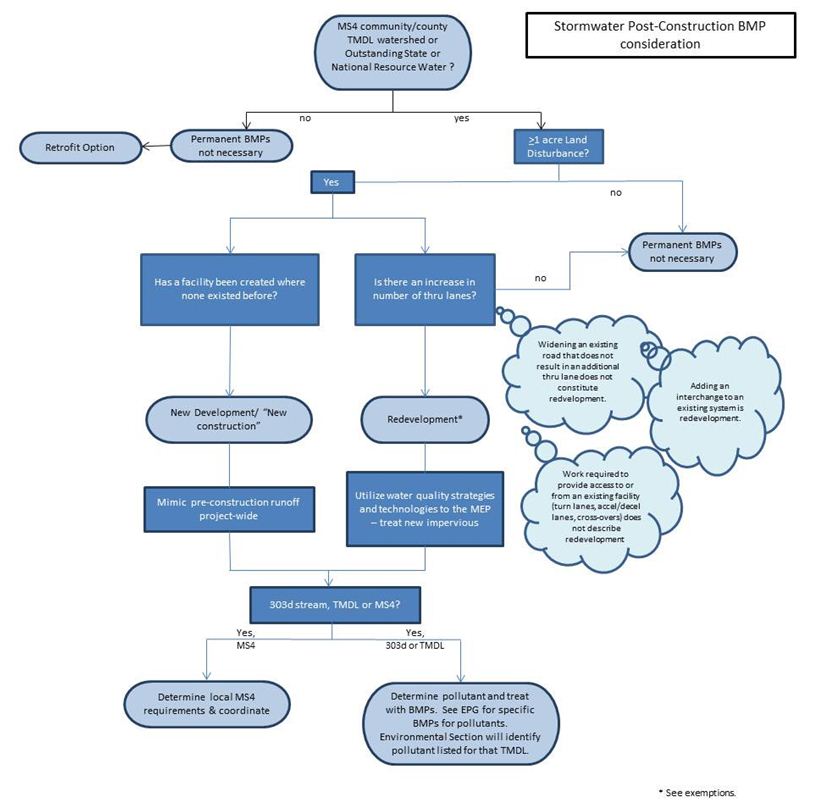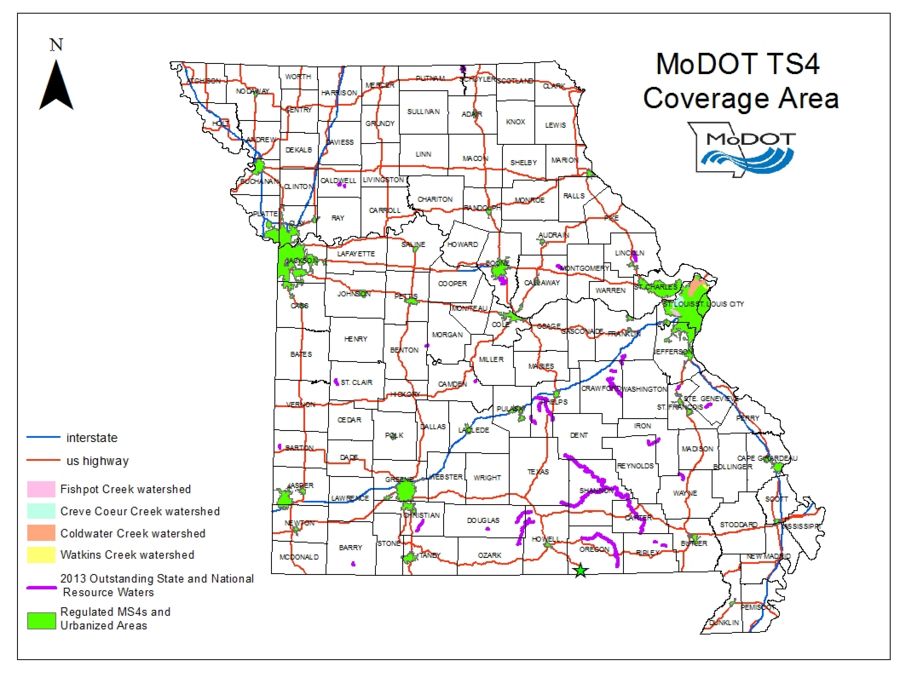127.29 Stormwater
Contents
- 1 127.29.1 Definitions
- 2 127.29.2 Purpose
- 3 127.29.3 MCM 1: MoDOT Community & Public Education and Outreach on Stormwater Impacts Program
- 4 127.29.4 MCM 2: MoDOT Community and Public Involvement/Participation Program
- 5 127.29.5 MCM 3: Illicit Discharge Detection and Elimination (IDDE) Program
- 6 127.29.6 MCM 4: Construction Site Stormwater Runoff Control
- 7 127.29.7 MCM 5: Post-Construction Stormwater Management in New Development and Redevelopment
- 8 127.29.8 MCM 6: Pollution Prevention/Good Housekeeping
- 9 127.29.9 Public Involvement for Stormwater
127.29.1 Definitions
Best Management Practice (BMP) – From MDNR’s 10 CSR20-6.200: Schedules of activities, prohibitions of practices, maintenance procedures, and other management practices to prevent or reduce the pollution of waters of the state. BMPs also include treatment requirements, operating procedures and practices to control plant site runoff, spillage or leaks, sludge or waste disposal, or drainage from raw material storage.
Boundary Point Source – a point source that is not an outfall. The location where the point source leaves MoDOT right of way.
Illegal connection - a pipe or other conveyance that has illegally been connected to MoDOT’s MS4.
Illicit discharge - is defined by MDNR's 10 CSR 20-6.200 as a discharge of pollutants to a Municipal Separate Storm Sewer System (MS4) that is not comprised entirely of storm water and is not authorized under the NPDES permit.
Major stormwater outfall – MDNR defines as “a municipal separate storm sewer outfall that discharges from a single pipe with an inside diameter of thirty-six inches (36") or more (or its equivalent)”. Reference: 10 CSR 20-6.
MoDOT Community – MoDOT staff and external partners including contractor’s and consultants.
MoDOT’s MS4 area – MDNR designated MS4/urban areas, outstanding state and national waters, Total Maximum Daily Load (TMDL) effective watersheds.
MS4 – Municipal Separate Storm Sewer System.
Municipal separate storm sewer - a conveyance or system of conveyances including roads and highways with drainage systems, municipal streets, catch basins, curbs, gutters, ditches, paved or unpaved channels, or storm drains designated and utilized for routing of storm water which:
- A. Does not include any waters of the state as defined in this rule;
- B. Is contained within the municipal corporate limits or is owned and operated by the state, city, town, village, county, district, association, or other public body created by or pursuant to the laws of Missouri having jurisdiction over disposal of sewage, industrial waste, storm water, or other liquid wastes;
- C. Is not a part or portion of a combined sewer system;
- D. Is not a part of a publicly owned treatment works as defined in 40 CFR 122.2; and
- E. Sewers that are defined as large or medium or small municipal separate storm sewer systems pursuant to paragraphs 10., 15., and 28. of this section, or designated under subsection (1)(B) of this rule.
New development – MoDOT defines new development for purposes of the MS4 permit, to mean projects (with land disturbance greater than or equal to 1 acre) that are constructed where there was previously no transportation facility.
Nonpoint source – a type of pollution that occurs when water runs over land or through the ground, picks up pollutants, and deposits them in surface waters or introduces them into groundwater.
Non-structural practices/controls - operational BMPs that prevent or reduce pollutants from entering storm water. Examples include preventative maintenance procedures, minimizing impervious surfaces, and spill prevention and cleanup.
Permanent BMP – a best management practice designed to be permanently left in place after construction to treat or contain stormwater.
Point Source – any discernible, confined and discrete conveyance, including but not limited to any pipe, ditch, channel, tunnel, conduit, well, discrete fissure, container, rolling stock, concentrated animal feeding operation, or vessel or other floating craft, from which pollutants are or may be discharged. Point source does not include agricultural storm water discharges and return flows from irrigated agriculture.
Pollutant - Dredged spoil, solid waste, incinerator residue, sewage, garbage, sewer sludge, munitions, chemical waste, biological materials, radioactive materials, heat, wrecked or discarded equipment, rock, sand, cellar dirt, filter backwash or industrial,municipal or agricultural waste discharged into water. Reference: Reference: 10 CSR 20-2.
Redevelopment - MoDOT defines redevelopment for purposes of the MS4 permit with respect to transportation facilities, to mean non-maintenance work performed to or on an existing public transportation facility which provides for an increased number of thru lanes of travel unless the work can be accommodated without increasing the width of the existing pavement. Widening of an existing road that does not result in an additional thru lane does not constitute redevelopment. Widening to add shoulders does not constitute a thru lane unless the total widening is greater than or equal to 10 feet.
Run-on – storm water from adjacent landowners or development that is combined with MoDOT’s storm water.
Storm water outfall – a point source where intentionally collected storm water exits the right of way (ROW) and enters a “water of the state”. For example, roadside ditch.
(Stormwater) Outfall – MoDOT defines an outfall as intentionally collected stormwater that is “A point source as defined by 10 CSR 20-2.010 at the point where a municipal separate storm sewer discharges and does not include open conveyances connecting two (2) municipal separate storm sewers, pipes, tunnels, or other conveyances which connect segments of waters of the state and are used to convey waters of the state.” Reference: 10 CSR 20-6.
Structural practices/controls - physical, structural or mechanical devices or facilities intended to prevent pollutants from entering storm water. Examples include building berms around potential pollutant source areas, roofs over outside truck wash bays, etc.
TMDL Total Maximum Daily Load - a mathematical calculation of the amount of a specific pollutant a waterbody can absorb and still meet water quality standards.
waters of the state – MDNR defines as “all rivers, streams, lakes and other bodies of surface and subsurface water lying within or forming a part of the boundaries of the state which are not entirely confined and located completely upon lands owned, leased or otherwise controlled by a single person or by two or more persons jointly or as tenants in common and includes waters of the United States lying within the state.” Reference: Missouri Revised Statutes 644.016.
Acronyms and Abbreviations
| BMP | Best Management Practice |
| CWA | Clean Water Act |
| EPA | Environmental Protection Agency |
| EPG | Engineering Policy Guide |
| ESC | Erosion and Sediment Control |
| FHWA | Federal Highway Administration |
| GI | Green Infrastructure |
| IDDE | Illicit Discharge Detection and Elimination |
| LID | Low Impact Development |
| MCM | Minimum Control Measure |
| MEP | Maximum Extent Practicable |
| MDNR | Missouri Department of Natural Resources |
| MoDOT | Missouri Department of Transportation |
| MS4 | Municipal Separate Storm Sewer System |
| MSD | Metropolitan Sewer District – St. Louis |
| NPDES | National Pollutant Discharge Elimination System |
| O&M | Operation and Maintenance |
| ROW | Right of way |
| SOP | Standard Operating Procedure |
| SPCC | Spill Prevention Control and Countermeasure |
| SWMP | Storm Water Management Plan |
| SWPPP | Storm Water Pollution Prevention Plan |
| TMDL | Total Maximum Daily Load |
| TS4 | Transportation Separate Storm Sewer System |
| UA | Urbanized Area as defined by US Census |
127.29.2 Purpose
Missouri Department of Transportation (MoDOT) is regulated under a National Pollutant Discharge Elimination System (NPDES) general, statewide storm water permit that requires MoDOT to develop and implement a comprehensive program to prevent pollution of surface waters resulting from storm water runoff. EPG 127.29.2 is intended to serve as general guidance to assist MoDOT staff and consultants in the selection, design, and maintenance of post-construction (i.e., permanent) best management practices (BMPs) in order to comply with water quality regulatory requirements. It is intended to achieve the following goals:
- Comply with storm water permit
- Provide an overview of important factors to be considered
- Offer guidance in the consideration of physical, operational, and cost (capital and maintenance) characteristics of post-construction best management practices (BMPs) for water quality.
Provisions of the Federal Clean Water Act and related state rules and regulations require a municipal separate storm sewer system (MS4) permit when the facility serves a population of 1,000 or more within an urbanized area or are located outside an urbanized area serving a jurisdiction with a population of at least 10,000 and a population density of 1,000 people per square mile or more. Furthermore, a municipal separate storm sewer means a conveyance or system of conveyances including roads and highways with drainage systems, municipal streets, catch basins, curbs, gutters, ditches, paved or unpaved channels, or storm drains designated and utilized for routing of storm water. MoDOT has an MS4 general permit, obtained from the Missouri Department of Natural Resources (MDNR), delegated by the Environmental Protection Agency (EPA). It requires MoDOT to develop and adhere to a Storm Water Management Plan (SWMP) comprised of six minimum control measures (MCMs) listed below.
127.29.3 MCM 1: MoDOT Community & Public Education and Outreach on Stormwater Impacts Program
Permit requirement. The permittee shall implement a MoDOT community education program to distribute educational material to the community or conduct equivalent outreach activities about the impact of stormwater discharges on waterbodies and steps that MoDOT community can take to reduce pollutants in stormwater runoff.
MoDOT shall establish BMPs under this program focused on the general public.
127.29.4 MCM 2: MoDOT Community and Public Involvement/Participation Program
The permittee shall implement a public involvement/participation program that provides opportunities for both public and MoDOT community involvement in the development and oversight of the permittee’s SWMP, and provides opportunities for both the public and MoDOT community involvement of the permittee’s renewal application. The public involvement/participation program shall, at a minimum, include the following:
- 1. A public notice period to allow the public and MoDOT community the opportunity to review the SWMP and renewal application prior to submission of the SWMP and renewal application to the Department. It is recommended that the public review period is at least 10 (ten) business days;
- 2. A plan to target potentially affected stakeholder groups with the purpose of allowing the opportunity to provide various viewpoints concerning appropriate stormwater management policies and BMPs.
- 3. If the permittee utilizes a stormwater management panel/committee, then the permittee shall provide opportunities for input for public and MoDOT Community on the panel/committee;
- 4. A notice of public hearing, if needed, regarding the SWMP and renewal application (See EPG 129.13 Public Involvement for Stormwater). It is recommended that the notice should be at least 72 hours prior to the meeting; and
- 5. A plan to provide opportunities for citizen volunteers to assist in conducting right-a-way clean-up activities.
The Public Notice (PN) for SWMP and renewal application will be a minimum of 10 days and will be posted on MoDOT’s Stormwater webpage in addition to being emailed statewide with an opportunity for public hearing (see EPG 129.13 Public Involvement for Stormwater). This specifically applies to the SWMP and renewal application which is submitted to MDNR every 5 years upon permit expiration.
127.29.5 MCM 3: Illicit Discharge Detection and Elimination (IDDE) Program
The permittee shall develop, implement, and enforce a program to detect and eliminate illicit discharges into the TS4. As part of the SWMP, the IDDE shall include, at a minimum, the development and implementation of:
- 1. A stormwater sewer map documenting the location of all known outfalls and the names and location of all receiving waters of the state that receive discharges from the TS4. The permittee shall make the map data and its origin available to the Department and EPA upon request;
- 2. To the extent allowable under state or local law, effectively prohibit through regulatory mechanism or equivalent non-stormwater discharges from illicit discharges into the TS4 and implement appropriate procedures or actions. The permittee shall identify in the SWMP the appropriate procedures or actions, if any, used to prohibit illicit discharges into the TS4;
- MoDOT’s policy regarding illegal connections and discharges into MoDOT’s system is described at EPG 127.25.8.3.2 System Attachments by Others and EPG 127.25.8.3.1 Industrial and Domestic Waste Waters on Right of Way.
- Notification of appropriate local or state agencies of illegal dumping or illicit discharges, as soon as practicably possible, is an acceptable enforcement procedure or action.
- 3. A plan and schedule to detect and address non-stormwater discharges, including discharges from illegal dumping and spills, to the TS4; Private homeowners are regulated by the Missouri Department of Health and Senior Services. The Missouri Department of Health and Senior Services is to be contacted when wastewater discharge from a private homeowner is found on the right of way. Commercial businesses and industries are regulated by MDNR. When wastewater discharge from a regulated entity is discovered on MoDOT right of way, the Environmental Specialist will contact MDNR to determine if the commercial business or industry has a valid operating permit issued by MDNR to discharge effluent.
- The Environmental Specialist will request MDNR to take whatever legal action necessary concerning any business or industry that does not have a valid permit from MDNR to discharge effluent to the highway right of way.
- 4. Inform the MoDOT community and the general public of hazards associated with illegal discharges and improper disposal of waste; and
- 5. The permittee shall address the categories of non-stormwater discharges or flows listed under Part A – COVERAGE AND RESTRICTIONS, item 2 (a – q) if the permittee identifies them as significant contributors of pollutants to the TS4.
Vehicular accidents are not considered illicit discharges unless the spill enters waters of the state.
For additional information see EPG 127.25.3.1 Rest Area Lagoon, EPG 127.25.8.3 Sewage Disposal System, and EPG 127.25.8.3.2 System Attachments by Others.
The Environmental Specialist will request MDNR to take whatever legal action necessary concerning any business or industry that does not have a valid permit from MDNR to discharge effluent to the highway right of way.
For additional information see EPG 127.25.3.1 Rest Area Lagoon, EPG 127.25.8.3 Sewage Disposal System, and EPG 127.25.8.3.2 System Attachments by Others.
Sources of illicit discharges are spills from roadway accidents, sanitary wastewater, effluent from septic tanks, improper oil disposal, laundry wastewaters, improper disposal of auto and household toxics, etc. See EPG 127.25.8.3.1 Industrial and Domestic Waste Waters on Right of Way and EPG 127.25.8.3.2 System Attachments by Others.
MoDOT is authorized to discharge the following non-storm water sources provided that the permitting authority has not determined these sources to be substantial contributors of pollutants to the permittee’s MS4 that require a separate permit:
- Landscape irrigation
- Rising ground waters
- Uncontaminated ground water infiltration
- Uncontaminated pumped ground water
- Discharges from potable water sources
- Foundation drains
- Air conditioning condensation
- Springs
- Water from crawl space pumps
- Footing drains
- Lawn watering
- Flows from riparian habitats and wetlands
- Street wash water
- Bridge wash water
- Discharges or flows from emergency firefighting activities
- Individual residential car washing
- Dechlorinated residential swimming pool discharges
127.29.6 MCM 4: Construction Site Stormwater Runoff Control
This measure covers our existing policy in EPG 806 Pollution, Erosion and Sediment Control Program.
Additionally, this measure is also covered within EPG 173 Erosion Control for Maintenance Operations.
The permittee shall develop, implement, and enforce a program to reduce pollutants in any stormwater runoff to their TS4 from construction activities on areas owned by MoDOT that result in a land disturbance of greater than or equal to one acre. Reduction of stormwater discharges from construction activities disturbing less than one acre must be included in the program if that construction activity is part of a larger common plan of development or sale that would disturb one acre or more. If the NPDES permitting authority waives requirements for stormwater discharges associated with small construction activities on areas owned by MoDOT in accordance with 40 CFR 122.26(b)(15)(i), then permittee is not required to develop, implement, or enforce a program to reduce pollutants discharges from such sites.
The permittee shall ensure for projects that result in land disturbances of greater than or equal to one acre that the program includes, at a minimum, the development and implementation of:
- 1. A regulatory mechanism or equivalent to require erosion and sediment controls, as well as sanctions to ensure compliance, to the extent allowable under state or local law;
- 2. Requirements for construction site operators to control waste such as discarded building materials, concrete truck washout, chemicals, litter, and sanitary waste at the construction site that may cause adverse impacts to water quality;
- 3. Procedures for plan reviews which incorporate considerations of potential water quality impacts to the receiving waterbody;
- 4. Procedures for receipt and considerations of information related to stormwater runoff controls submitted by the MoDOT community or general public; and
- 5. Procedures for site-inspections and enforcement of control measures.
127.29.7 MCM 5: Post-Construction Stormwater Management in New Development and Redevelopment
The permittee shall develop, implement, and enforce a program to address the quality of stormwater runoff from new development and redevelopment projects on areas owned and operated by MoDOT that disturb greater than or equal to one acre, including projects less than one acre that are part of a larger common plan of development or sale that discharge to the TS4. The program shall include, at a minimum, the following information:
- 1. Strategies to minimize water quality impacts, which includes a combination of structural and/or non-structural BMPs appropriate for the TS4, including but not limited to the assessment of site characteristics at the beginning of the construction site design phase to ensure adequate planning for stormwater program compliance. The goal of this approach is to arrive at designs that protect sensitive areas, minimize the creation of stormwater pollution, and utilize BMPs that effectively remove stormwater pollution. This can be achieved by reasonably mimicking pre-construction runoff conditions on all affected new development projects, or the permittee may achieve this goal through a method more appropriate for its community;
- 2. A regulatory mechanism or equivalent to address post-construction runoff from new development and redevelopment projects to the extent allowable under state or local law; and
- 3. Policies or procedures to ensure adequate long-term operating and maintenance of the BMPs.
Structural vs Non-structural Practices and Controls
Non-structural practices/controls are BMPs that are planning procedures or site-specific BMPs such as riparian zone preservation, minimization of disturbance and imperviousness, and maximization of open space. Structural BMPs fall into three categories (EPA Fact Sheet) or three main types of treatment BMPs. These three types are not mutually exclusive, but one BMP may fit into more than one type.
Retention/Detention BMPs: These types of BMPs gather runoff and hold it while slowly releasing it into drainage systems or receiving waters. These can be designed to control storm water volume and settle out particulates. Examples include: dry detention basins, wet detention basins, biodetention, stormwater wetland, wet ponds, etc.
Infiltration BMPs: These types of BMPs encourage filtration through soil to groundwater which results in reduced storm water runoff quantity and therefore pollutants. Examples include infiltration trenches/ditches/basins, grassy swales, pervious pavement, and infiltration basins or trenches.
Vegetative BMPs: These types of BMPs are landscape features that remove pollutants and facilitate percolation of runoff by maintaining natural site hydrology. Examples include grassy swales, filter strips, rain gardens, and wetlands.
| Potential Storm Water Controls | ||
|---|---|---|
| BMP | Definition | Function |
| Filtration Basin | A shallow basin with engineered media or soil and an underdrain. | Filtration, sorption, biological uptake, microbially mediated transportations. |
| Retention Basin | A wet basin that permanently holds water and limits discharges to large storm events. | Storage, detention, sedimentation |
| Bioretention Basin | A type of filtration basin with engineered media, an underdrain and landscaped vegetation. | Filtration, sorption, biological uptake, microbially mediated transportations. |
| Dry Detention Basin | A dry basin that temporarily holds water and slowly releases it over time. | Detention, sedimentation, sorption. |
| Rain Garden | A planted shallow depression that collects rainwater run-off from roof, parking lots and other surfaces. While a rain garden can blend into the landscape and serve as a garden area, its main function is to retain and treat collected storm water. | Detention, filtration, sorption |
| Filter Strip | A linear section of land, either grassed or forested that physically infiltrates storm water. | Filtration, infiltration, sorption, microbially mediated transformation, biological uptake. |
| Swale | A broad and shallow U-shaped channel with dense vegetation. | Filtration, infiltration, sedimentation, microbially mediated transformation, biological uptake. |
| Infiltration Basin | A shallow basin in permeable soils that detains and infiltrates storm water runoff. | Infiltration, sorption. |
| Level Spreader | A trough and level lip used to redistribute concentrated storm water as diffuse flow and sometimes combined with a filter strip. | Energy dissipation, infiltration. |
| Wet Detention Basin | A shallow basin that maintains a permanent pool of water using a control structure. | Detention, sedimentation, biological uptake, microbially mediated transformations. |
| Preformed Scour Hole | A riprap lined basin formed at the outlet of a pipe. | Energy dissipation, infiltration. |
| Forebay | A small basin located upstream of another storm water control. | Detention, sedimentation. |
| Storm Water Wetland | Lands on which water is present either at or near the surface of the soil permanently or seasonally and supports wetland vegetation such as cattails. | Detention, sedimentation, sorption, biological uptake, microbially mediated transformations. |
| Proprietary Structure | Structure/system that a company or person owns rights to. | Various |
FHWA provides a good overview of BMPs and the expected treatment and maintenance of each.
Project Delivery Process
The projects will be reviewed using the request for environmental services (RES) process to screen projects for compliance with this requirement. The RES “Storm water/Water Quality” section should be addressed beginning at the initial/scoping phase for all projects that have greater than or equal to 1 acre of land disturbance and meeting the criteria of redevelopment or new development. See Fig. 127.29.7.2 Storm Water Post-Construction BMP Consideration. The storm water specialist will review RESs that meet these minimum requirements.
- Is the project within an MS4 area, TMDL watershed or cross an Outstanding State or National Resource water as identified in Tables D and E in CSR 20-7.031? (Refer to MS4 area map).
- Does the project disturb ≥ 1 acre?
- Does the project meet the definition of redevelopment or new development?
If “yes” to all of these, then the project must consider permanent BMPs.
MoDOT has defined redevelopment, for purposes of the MS4 permit with respect to transportation facilities, to mean non-maintenance work performed to or on an existing public transportation facility which provides for an increased number of thru lanes of travel unless the work can be accommodated without increasing the width of the existing pavement (with land disturbance greater than or equal to 1 acre). Widening of an existing road that does not result in an additional thru lane does not constitute redevelopment. Widening to add shoulders does not constitute a thru lane unless the total widening is greater than or equal to 10 feet.
Examples include adding a through lane, widening a bridge by a lane width or widening shoulders that cumulatively add up to the addition of a lane width, etc.
MoDOT has defined new development (new construction), for purposes of the MS4 permit, to mean projects (with land disturbance greater than or equal to 1 acre) that are constructed where there was previously no transportation facility.
Examples include a new interchange on existing facility, adding an outer road where none existed previously, new facility where none existed previously, etc.
MoDOT has defined maintenance, for purposes of the MS4 permit, to mean projects that do not meet the criteria of redevelopment or development.
Examples include ramp widening or extending (less than a lane width), signal installation, intersection improvements, retrofitting an existing interchange (for example, typical to a DDI), slide repair, adding shoulders that is less than a lane width, guardrail replacement, resurfacing, and overlay projects.
If a project meets the criteria listed above for development or redevelopment, permanent post construction BMPs must be considered that treat the new impervious runoff in redevelopment and mimic the pre-existing runoff condition in new development. The district designer shall work with the stormwater specialist to consider site constraints and opportunities. If part of a project is determined to be “new development” the entire project is captured under those requirements. General design philosophy will seek to mimic natural hydrology through dispersal and infiltration of runoff.
The district designer shall determine new runoff storage for redevelopment and pre-existing runoff in new development. Treatment BMPs are engineered storm water treatment facilities and should be designated on all phases of plan sheets. Many of these measures will capture and hold water and potentially develop wetland characteristics over time. If these are designated as storm water treatment facilities, they will not be under the US Army Corps of Engineers jurisdiction as wetlands. Conversely, storm water BMPs should not be sited within an existing jurisdictional wetland or its natural vegetated buffer except by permit or as part of a wetland mitigation plan. Wetlands may be considered for runoff treatment by passive means of dispersal.
In areas where the drainage is not captured via curb and gutter, open-bottom, grassy ditches will serve as permanent BMPs. Grassy swales (i.e., ditches), while an important BMP, will not be tracked and inspected in MoDOT’s database of stormwater BMPs and therefore not inspected under that program. Grassy swales are defined as a flat-bottomed or U-shaped ditch. If a flat-bottomed or U-shaped ditch cannot be achieved due to other site constraints, ditch blocks/checks can be used in conjunction with V-shaped ditches to achieve infiltration and absorption goals. Additionally, grassy medians that capture drainage are also included as a post-construction BMP but not tracked and inspected.
Example List of Commonly Used Post-Construction Control Practices:
- Infiltration basins
- Detention/retention
- Vegetated strips and/or swales
- Biofilters
- Permanent erosion control, seeding and planting
- Outlet protection/velocity dissipation devices
- Earth dikes, drainage swales and lined ditches
- Bridge slope protection
- Rock slope protection
- Mulching
- Verification that interior drains are not connected to a storm sewer system
Special Watersheds with TMDLs in Effect
In project areas where a TMDL is in effect, it is feasible to tailor a permanent BMP to the pollutant identified. The American Association of State Highway Transportation Organization’s (AASHTO) Drainage Manual 2014 provides a table (Table 7-2) with the “Effectiveness and Applicability of Management Measures” for various permanent BMP control measures’ ability to remove specific pollutant types such as particulates, heavy metals, pesticides and organics. An example in table shows that curb elimination (promoting sheet flows) is highly effective at removing particulates, heavy metals and organics.
Special Watersheds where MoDOT has been assigned a Wasteload Allocation (WLA)
There are currently 4 watersheds where MoDOT has been assigned a WLA. These are all in the St. Louis District. They are Coldwater Creek, Watkins Creek, Creve Coeur Creek and Fishpot Creek. When a new or redevelopment project is within any of these watersheds, MoDOT will first consider and give more value to media filters, bioretention and retention as BMPs. This shall be done in accordance with the MCM5 requirement to consider BMPs when a project disturbs ≥ 1 acre, is within the TS4 area, and meets the definition of redevelopment or new development.
By the final RES stage submittal, the project shall include the location of the permanent BMP(s) on the plan sheets and noted under Water Quality/Stormwater section, for entry into the BMP database.
General Exemptions
Once a project has met the qualifying criteria of redevelopment or new development, post construction BMPs must be considered during the project delivery process. If it is not feasible to place permanent post construction BMPs in the project area due to constraints such as utilities, right-of-way, safety, environmental or cost, written justification must be documented in the project file. While permanent BMPs may not be feasible, the projects must still adhere, at a minimum, to MCM 4 Construction Site Runoff Control and MCM 6 Pollution Prevention and Good Housekeeping measures. Below are some general exemptions:
- Projects where the only work involved is the addition or rehabilitation of paved surfaces not intended for use by motor vehicles (such as sidewalks or bicycle/pedestrian trails).
- Removing and replacing a concrete or asphalt roadway to base course, or subgrade or lower, without expanding the impervious surfaces.
- Permit projects where MoDOT is not building/letting and the project is not on MoDOT right of way (designed by MoDOT but let by others).
Coordination with Adjacent MS4 Community
During the scoping phase of the project delivery process, if a project is located within another MS4 regulated area, it is recommended the community be contacted by district staff or environmental staff to determine whether the community has post construction requirements under their permit program. Another option is to investigate the community’s website or other resource to determine if they have specific requirements. A general review of the MS4 community’s MCM 5 Post Construction Runoff Control requirements shall be conducted. The district shall use all pertinent BMP information to determine the preferred treatment BMPs or other BMP opportunities in the watershed. Since MoDOT is regulated by MDNR under a MS4 permit, MoDOT is not required to comply with another MS4 regulated community’s requirements. However, the district should make an effort to coordinate with the community in an effort to share responsibilities.
If the MS4 community can provide a storm water treatment option off MoDOT right-of-way, it is most beneficial to pursue that opportunity. Working with MS4 communities to partner for long-term management and maintenance is preferred.
Projects that are Located Partially Inside an MS4 Community
If a MoDOT project is partially within the MS4 coverage area, but partially outside of the MS4 coverage area, permanent BMPs shall only be considered within the MS4 coverage area. The entire project description shall be used to determine the type of project, redevelopment or development, and therefore type of treatment.
If it is not feasible to include permanent BMPs in the project and there are opportunities within the portion of the project outside the MS4 area, a swap is acceptable.
Cost-Share Projects and Unique Funding Projects
For cost-share projects within the MS4 area, permanent BMPs shall be applied using the flow chart to areas on MoDOT right of way that is applicable.
If it is not feasible and there are opportunities within the adjacent MS4 community, a swap is acceptable. An agreement for long-term maintenance must be agreed to by both entities.
If funding is through the community or county and MoDOT is only providing engineering services, post-construction BMPs are not required to be considered by MoDOT but may be required by the community or county under their stormwater permit.
Cost-Share projects that are entirely specific to a design element, such as railroad grade separations, sidewalks, etc. may be exempt if no other work is involved in that MS4 project area.
Projects as a Result of Adjacent Development
If a project is a result of an adjacent development and would not have otherwise been constructed by MoDOT, the water quality and/or quantity features shall be included in that development.
Traffic permits
If adjacent developments require an access permit and are within the MS4 coverage area, runoff from adjacent development must be treated prior to entering MoDOT right of way or directed away from MoDOT right of way.
Adjacent development that drains to MoDOT right of way cannot increase flows from the pre-construction condition.
127.29.8 MCM 6: Pollution Prevention/Good Housekeeping
The permittee shall develop and implement an operation and maintenance program with the goal of preventing or reducing pollutant runoff from MoDOT operations and maintenance located in areas established in Part A – COVERAGE AND RESTRICTIONS, item 1. As part of the SWMP, the pollution prevention/good housekeeping program shall include:
- 1. BMPs designed or developed with the purpose of reducing floatables or other pollutants into the TS4 or waters of the state;
- 2. Inspection procedures and schedules ensuring that structural BMPs are being implemented;
- 3. A list of all MoDOT operations and maintenance areas subject to this program (MoDOT Facilities within the TS4 area); and
- 4. MoDOT community training on BMPs to prevent or reduce stormwater pollution from, but not limited to, the following activities:
- Welcome centers, rest areas, and commuter lots;
- Fleet and building maintenance;
- New construction and land disturbances;
- Stormwater system maintenance; and
- Bridge washing and cleaning activities.
- 5. Controls for reducing or eliminating the discharge of pollutants from highways and MoDOT owned and operated parking lots, maintenance and storage yards, waste transfer stations, fleet or maintenance shops with outdoor storage areas, and salt/sand storage locations and snow disposal areas at MoDOT building and lots.
Facility Runoff Control Plans (FRCP) are required at all MoDOT maintenance and operations areas referenced above. These plans outline good housekeeping and pollution prevention best management practices to reduce or eliminate pollutant laden runoff from MoDOT’s maintenance and operations facilities. The plans outline target pollutant education, inspection obligations, and corrective action guidance for those facilities and operations within the TS4 area.
FRCP inspections are required to be completed once every six (6) months. Inspections must be completed by a qualified facility inspector. Qualifications are outlined in the FRCP plan. Inspection forms and corrective measure documentation forms are included in the FRCP plan and are to be maintained for a period of three (3) years at the facility or electronically as determined by district maintenance management. FRCP plans, inspections, and corrective actions identified during inspections must be accessible and made available to regulating agency personnel upon request.
See 10 CSR 20-6.200.
MoDOT’s Coverage Area
References:
EPA guidance on minimum control measures, National Menu of Stormwater BMPs.
EPA SWMM model for stormwater BMPs.
AASHTO, 2014, AASHTO Drainage Manual, 1st Edition, American Association of State Highway and Transportation Officials.
127.29.9 Public Involvement for Stormwater
A public hearing may be requested during the public notice period for MoDOT’s TS4 Site-specific State Operating Permit. The public notice will be posted on MoDOT’s stormwater page and emailed to media statewide when MoDOT is submitting a renewal application to the MDNR, typically every five years.
The request must give reasonable cause for holding the hearing. A public hearing will be held if there is significant technical merit and concern related to the responsibilities of MoDOT. At least 30 days prior to the hearing MoDOT will post public notice of the hearing. The hearing will be held in the geographic area appropriate to the request.
